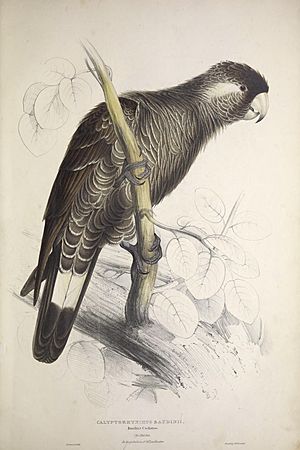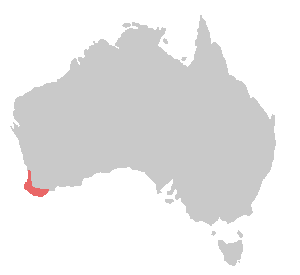Baudin's black cockatoo facts for kids
Quick facts for kids Baudin's black cockatoo |
|
|---|---|
 |
|
| Holotype. Lear. 1832. | |
| Conservation status | |
| Scientific classification | |
| Genus: |
Zanda
|
| Species: |
baudinii
|
 |
|
| Range in red, within Australia | |
The Baudin's black cockatoo (Zanda baudinii) is a special type of parrot. It is also known as Baudin's cockatoo or the long-billed black cockatoo. This bird lives only in southwest Australia. It is named after a French explorer, Nicolas Baudin.
This cockatoo has a small crest of feathers on its head. Its body is mostly greyish-black. It has clear white patches on its cheeks and a white band on its tail. The edges of its body feathers are white, which makes them look like scales. Adult males have a dark grey beak and pink rings around their eyes. Adult females have a bone-colored beak and grey eye-rings. Their ear patches are also lighter than the males'.
Contents
What's in a Name?
The Baudin's black cockatoo was first drawn by Edward Lear in 1832. He included it in his book, Illustrations of the Family of Psittacidae, or Parrots. He drew a female bird that belonged to Benjamin Leadbeater. This drawing helped scientists identify the species.
For a long time, the Baudin's black cockatoo and the Carnaby's black cockatoo were thought to be the same species. But now, scientists know they are different.
These two cockatoos, along with the Yellow-tailed black cockatoo from eastern Australia, belong to the same group called Zanda. This group was once part of a larger group, Calyptorhynchus. The main difference between these groups is how their young birds call for food. Also, males and females in the Calyptorhynchus group look very different. But in the Zanda group, they look quite similar.
How to Spot a Baudin's Black Cockatoo
Baudin's black cockatoo is about 56 centimeters (22 inches) long. Its feathers are dark grey with thin, light grey edges. This gives them a slightly scaly look. It has a short crest on its head. White feather patches cover its ears. The outer tail feathers are white with black tips. The middle tail feathers are all black.
Its eyes are dark brown, and its legs are grey-brown. The beak of a Baudin's cockatoo is longer and thinner. This helps tell it apart from the similar Carnaby's black cockatoo.
Male Baudin's cockatoos have a dark grey beak and pink rings around their eyes. Females have a bone-colored beak and grey eye-rings. Their ear patches are also lighter. Young cockatoos have a bone-colored beak and grey eye-rings. They also have less white on their tail feathers. Some of these birds have lived for over 47 years!
Where Do They Live?
Baudin's black cockatoos live only in southwest Australia. They prefer wet, heavily forested areas. They especially like places with many marri trees (Corymbia calophylla). Sadly, their homes are being destroyed, which is a big problem for them.
Helping Them Survive
The number of Baudin's black cockatoos is getting smaller. Scientists believe there are only about ten to fifteen thousand left. Because of this, they are listed as an endangered animal. This means they are at high risk of disappearing forever.
To help these birds, people hold an event every year called the Great Cocky Count. This count has been happening since 2009. It helps track how many Baudin's and other black cockatoos are left. This information helps conservation efforts.
Some special places are very important for protecting Baudin's black cockatoos. These are called Important Bird Areas. They include Araluen-Wungong, Gidgegannup, Jalbarragup, Mundaring-Kalamunda, North Dandalup, the Stirling Range, and The Lakes.
Images for kids
See also
 In Spanish: Cacatúa fúnebre piquilarga para niños
In Spanish: Cacatúa fúnebre piquilarga para niños






